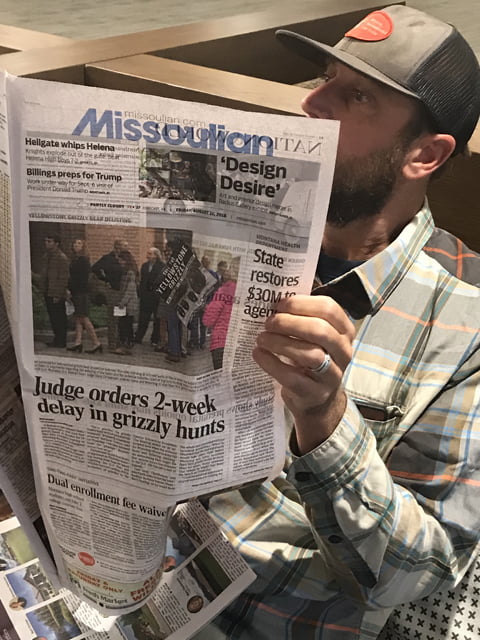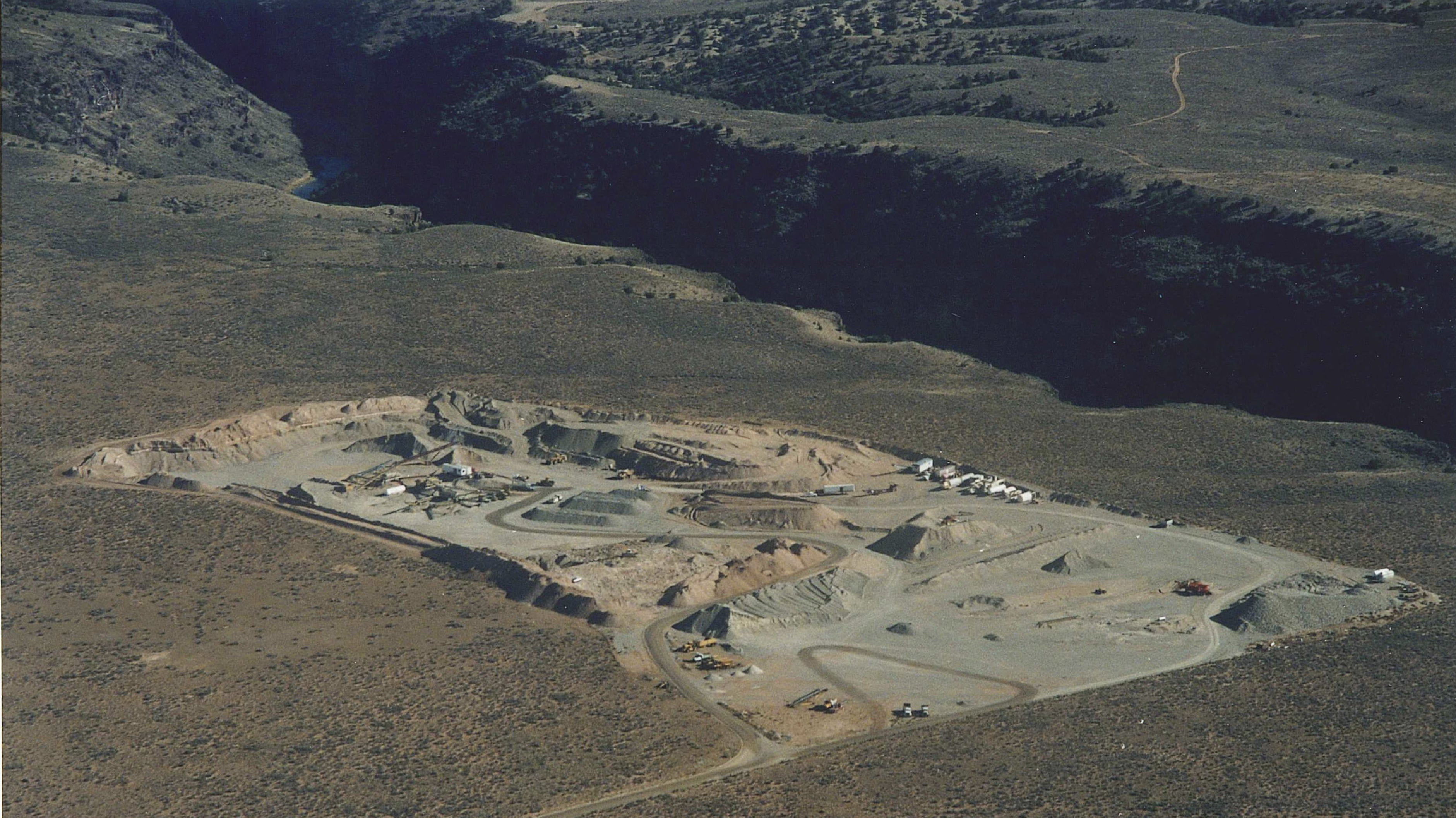Extinction’s Opposing Counsel
What Drives Matt Bishop to Protect Predators
Wildlife attorney Matt Bishop has dedicated his career to fighting extinction. He focuses on predators – keystone species whose importance to ecosystem health can’t be overstated. Likewise, Matt’s success in defending those species has had an outsized impact across the West. Matt’s fellow WELC attorney Laura King wrote this profile on Matt, offering a look inside our Montana office and what drives extinction’s opposing counsel.
Extinction’s Opposing Counsel
What Drives Matt Bishop to Protect Predators
Wildlife attorney Matt Bishop has dedicated his career to fighting extinction. He focuses on predators – keystone species whose importance to ecosystem health can’t be overstated. Likewise, Matt’s success in defending those species has had an outsized impact across the West. Matt’s fellow WELC attorney Laura King wrote this profile on Matt, offering a look inside our Montana office and what drives extinction’s opposing counsel.
Extinction’s Opposing Counsel
What Drives Matt Bishop to Protect Predators
Wildlife attorney Matt Bishop has dedicated his career to fighting extinction. He focuses on predators – keystone species whose importance to ecosystem health can’t be overstated. Likewise, Matt’s success in defending those species has had an outsized impact across the West. Matt’s fellow WELC attorney Laura King wrote this profile on Matt, offering a look inside our Montana office and what drives extinction’s opposing counsel.

Matt repairs an adobe church in Picuris Pueblo in 1999. Photo: Dina Gonzales.
Wildlife attorney Matt Bishop’s office is covered in pictures, with almost no white space in between. Redolent with incense and anchored by several Buddhas, his office feels like a kind of temple, if temples chugged with funky, soft music and had elderly canine rugs that lifted their heads for occasional pets. It’s a Friday afternoon, and Matt has agreed to sit down with me for an interview in the Helena, Montana office of the Western Environmental Law Center, where we both work.
As he finishes tapping arguments into his computer (“may delist only if the best available science shows,” “must provide a reasoned explanation for disregarding facts”), I check out his cheering section: posters of Ed Abbey, whose gaze insists courage needs no apology; Bob Dylan, eyes lowered as if sighting down the barrel of truth; John Muir, hands clasped behind his back, at home in Yosemite’s vast rightness; and wolverines and lynx, caught by remote camera, but ready to stride out of obscurity on the path of Matt’s typed page.

Reading the coverage of the grizzly hunt injunction after oral argument the previous day (August 21, 2018). Photo: John Mellgren.
A RECORD OF SUCCESS
Leaving his computer, Matt joins me in a pair of upholstered armchairs next to case files stacked some 5 feet high and 9 feet wide—a monument of hard work. He’s tall, with a face that’s seen weather and a beard just this side of scruffy. Setting his large hands on his long legs, he has the disarming air of a gentle giant—an impression his actions confirm: When he’s not at his computer, he might be found cutting lilacs for our conference room table or offering empathy and ideas to the struggling restaurateur across the way. But like mild-mannered Clark Kent, his secret is he’s a force of nature. Since 1998, Matt has won almost all of the 50-some cases he has brought as lead counsel in federal (and occasionally state) court, saving lynx, wolverine, Sonoran Desert tortoises, bull trout, and Mexican wolves from trophy hunting, trapping, and paltry protections, and saving special places from intrusions like logging and off-road vehicles. In one of his latest wins, he and his co-counsel reinstated Endangered Species Act protections for grizzly bears in the Yellowstone region.
CLIMATE & WILDLIFE: WE’VE GOT TO DO BOTH
Matt disagrees that work to restore wildlife in an era of climate change is like shuffling the deck chairs on the Titanic. “We’ve got to do both,” he says, his blue eyes steady behind black-rimmed glasses. “If you save the ship, make sure there are still deck chairs there.” When I ask about his vision for his work, Matt describes an ideal future where wild ecosystems are interwoven with human communities. “I’d love to see bears in Colorado and across the Sierras,” he says, his hands marking the air with goalposts. Bears are on his mind today, with appeal briefs in the grizzly suit scheduled to arrive this afternoon, but they’re just one example of the “teeth in the scenery” Matt would like to see—a phrase from Doug Chadwick’s Wolverine Way. He quotes the full passage with near-perfect memory: “If the living systems we choose to protect aren’t large and strong and interconnected, then we aren’t really conserving them. Not for the long term. Not with some real teeth in the scenery. We’re just talking about saving nature while we settle for something less wild.” The crickets and birds seem to chorus their agreement from Matt’s open office door.
Matt’s respect for wildlife has been with him all his life. He doesn’t know quite where it comes from, but he remembers his tears as a small boy on fishing trips when a fish was caught and its head smashed, and his resonance with his family’s agreement to let a snag hang over their house because it was good woodpecker habitat.
.
.
NO HUNTER’S GENE
What’s striking about Matt is that his big heart for animals hasn’t been dimmed or confounded by growing up in a world ambivalent about wildlife. On the one hand, there’s his mother, an avid birdwatcher who learned to love birds during summers spent as a child in a cabin in Bolinas, on the Northern California coast. On the other hand, growing up in Montana, he has seen his share of what he calls ego hunting, fueled by boast and competition. But he also grew up among conservationist hunters, including family friends whose patriarch, Jim Posewitz, is the author of several books that eloquently champion ethical hunting. Matt himself doesn’t have the “hunter’s gene” (or even the angler’s gene), he has come to understand. As a child, plucking the sleek feathers from the first pheasant he shot, he remembers thinking he would rather just know the bird was out in the wild, raising young. And yet, as a wildlife attorney, he has found some of his closest allies in hunters like Posewitz and his wife, biologist Gayle Joslin, of Helena Hunters and Anglers.
On a recent field trip he took with Gayle to a roadless area threatened by logging, he was struck by her intimate knowledge of the area—gained, in part, from the close attention and significant investment of time she has paid to the landscape by scouting its many miles on foot or squatting in its shadows with a gun or bow in her hands. That knowledge will be key in arguing the case he has brought to protect the area—which provides habitat for elk, deer, bear, lynx, and wolverine—including to rebut the Forest Service’s claim that it is merely improving existing roads to access trees. In fact, as Matt and Gayle ground-truthed, the “roads” that the Forest Service wants to “improve” in the roadless area are just threadlike animal trails.
TRUMAN THE ELDER
On cool mornings, one of our resident animals, Matt’s dog, Truman, can be found sitting in front of the rock outcrop across the sidewalk from Matt’s office, his regal head lifted. Truman has been the elder in our two-dog office, as Matt has been the elder in our three-human office. Together, Matt and Truman balance the puppy enthusiasm emanating from the office’s younger quarters with the slow burn of commitment.
VAN LIFE, DEBT, AND DEDICATION
Matt seems almost surprised to find himself an elder. A 21-year veteran of environmental lawyering, Matt carries his beginnings with him. When he was hired as a volunteer lawyer in the Taos, New Mexico office of WELC in 1998, he lived out of his ’87 pop-top Volkswagen. Mornings before coming into the office, he communed with the subject of his work by splashing his face with the water of the Rio Grande. Meanwhile, he racked up $10,000 in credit card debt and worked without boundary—pulling all-nighters, sometimes, to get a brief done. That wasn’t his style, but a senior attorney’s. Now, he carefully plans his time on a paper desk calendar, buttoning up all volatility except the flares—unexpected motions or appeals—that are an inescapable part of litigation.
HOME TO HELENA
 Matt founded our current office in Montana after 10 years in Taos. Currently housed in old gold miner’s quarters, the office has no central heat or AC, yet Matt’s space is always the coolest of our offices in summer and the coziest in winter. Although this could be just a bit of climatic good fortune, it’s actually a product of good systems, I think—which is emblematic of Matt. Whether it’s windows and fans or facts and the law, his magic is that he has identified what works and uses it. His list of victories is long because his list of must-dos is short (not to say easy): spend lots of time with the facts, call on scientific experts, avoid hypertechnical gotchas, and tell a simple, compelling story.
Matt founded our current office in Montana after 10 years in Taos. Currently housed in old gold miner’s quarters, the office has no central heat or AC, yet Matt’s space is always the coolest of our offices in summer and the coziest in winter. Although this could be just a bit of climatic good fortune, it’s actually a product of good systems, I think—which is emblematic of Matt. Whether it’s windows and fans or facts and the law, his magic is that he has identified what works and uses it. His list of victories is long because his list of must-dos is short (not to say easy): spend lots of time with the facts, call on scientific experts, avoid hypertechnical gotchas, and tell a simple, compelling story.
Many of Matt’s cases turn on striking revelations from agency emails, as in his recent wolverine listing case. There, the emails gave (as they often do) an account of agency wrongdoing: Agency biologists evaluated the relevant “threat factors” and communicated that the wolverine qualified for listing. Others in the agency field office confirmed the decision to list. And then came an eleventh-hour decision from upper management not to list. Untethered from the scientists’ findings, that last-minute decision was clearly political, illegal—a “flip-flop.”
But revelations like these are becoming harder to see under a new government policy to exclude emails from the record. Transparency is essential to justice under our environmental laws, as are opportunities, currently under fire, for lawyers to recover their fees under statutes and caselaw designed to incentivize “private attorneys general.” “Otherwise, only the wealthy get to take it to the courthouse,” Matt says.

Waiting out a thunderstorm on the Continental Divide in the Anaconda-Pintler Wilderness, one of the last remaining places still occupied by wolverine in the lower 48. Matt, in orange, is with his close childhood friend, Jamul Hahn. Photo: John Bennett.
SUE THE KING—AND SEE SOME REAL RESULTS
But despite the current administration’s efforts to undermine it, U.S. law still provides the legal framework that allows citizen Davids to stand up in court against the government Goliath. One of Matt’s first and favorite clients were two jewelry makers, a couple, who sold their wares on a bridge spanning the Rio Grande Gorge and complained of a sand and gravel mining operation that the government had approved on the rim of the Gorge, marring the spectacular view in violation of the Wild and Scenic Rivers Act. Matt remembers the couple’s palpable relief and profusion of thanks when they learned he would take their case—for free. Matt concluded the case in a settlement requiring the removal of the mine operation and the re-seeding of the site. It’s a case that stands out to him because it shows how U.S. law empowers anyone to “sue the king—and see some real results,” he says, his voice tinged with the sense of agency that the law confers.

The former mine. Photo: LightHawk

The timeless gorge in Taos. Photo: Bud Branch
Real results include striking on-the-ground changes, like reclamation of the gravel mining operation, or “the grizzly bear situation,” Matt reflects, recalling a recent case in which he was able to stop a sport hunt. “Maybe there were twenty plus grizzly bears that weren’t shot this year as trophies thanks to the injunction,” he says, and then his voice softens with reverence: “You can’t put a price on that.”
Real results also include the checks and balances provided by environmental lawyers who incrementally improve government decisionmaking through steady pressure. Wildlife and wild places urgently need both: both on-the-ground rescue and the grace of more thoughtful, reasoned

With the next generation: Floating the Missouri River with his children and their friends. Photo: Kristin Bishop.
government decisions. According to an independent intergovernmental report, “Around 1 million animal and plant species are now threatened with extinction, many within decades, more than ever before in human history.”
Along with the other vignettes from his childhood, Matt tells of the time when, on a family float trip, his mother dived off the raft to save a prairie dog that had fallen into the water. I think something in Matt went with her—is still going with her. Annie Dillard said “you have to fling yourself at what you’re doing, you have to point yourself, forget yourself, aim, dive.” As I work in my office next to his, sometimes I think I can sense the disturbance in the air as Matt dives, with the slow, sure speed of litigation, after another sputtering species that has lost its grip on the unforgiving rock face of our times.

By Laura King


